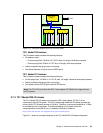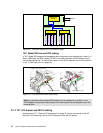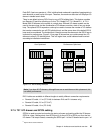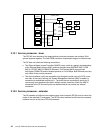
Chapter 2. Architecture and technical overview 41
Partition Load Manager
The Partition Load Manager (PLM) is part of the Advanced POWER Virtualization feature. It
provides automated processor and memory distribution between dynamic LPAR and
Micro-Partitioning capable logical partition running AIX 5L. The PLM application is based on a
client/server model to share system information, such as processor or memory events,
across the concurrent present logical partitions.
To improve the overall resource utilization of a partitioned system, PLM uses user-defined
resource management policies to determine the additional resources, such as processors
and memory, for each requesting partition.
For network communication, the PLM uses the Resource Monitoring and Control (RMC)
subsystem, which provides several events on every managed node. The following events are
registered on all managed nodes:
Memory-pages-steal high thresholds and low thresholds
Memory-usage-high thresholds and low thresholds
Processor-load-average high threshold and low threshold
To ensure a secure communication between managed nodes, OpenSSH and Kerberos V5
are supported in PLM to have a secure communication and an authentication mechanism for
administrators. If Kerberos is not installed, PLM uses the configured authentication method,
such as AIX authentication.
2.10 Service processor
The service processor (SP) is an embedded controller that is based on a PowerPC 405GP
processor (PPC405) running the SP internal operating system. The SP operating system
contains specific programs and device drivers for the SP hardware.
The p5-570 includes the SP. The key components include an FSP-Base (FSP-B) and an
Extender chipset (FSP-E). FSP-B and FSP-E are implemented on a dedicated card.
Note: The Shared Ethernet adapter and Virtual SCSI server functions are provided in the
Virtual I/O Server that is included in the Advanced POWER Virtualization feature
(FC 7942), an additional feature of p5 systems.


















